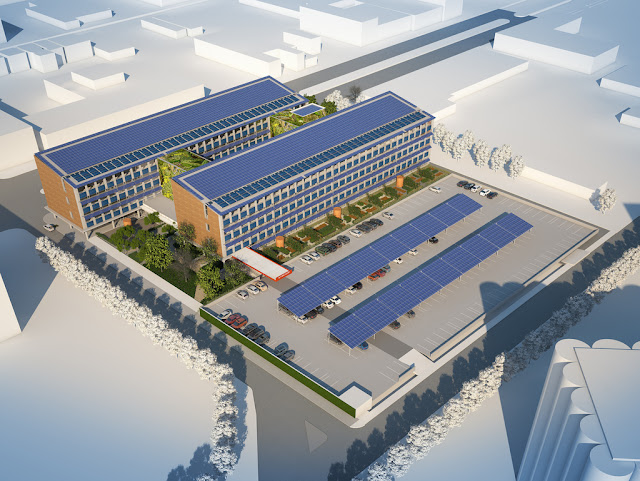Zero Energy Building & Alternate Building Materials
A zero-energy building, also known as a zero net energy (ZNE) building, net-zero energy building (NZEB), or net zero building, is a building with zero net energy consumption, meaning the total amount of energy used by the building on an annual basis is roughly equal to the amount of renewable energy created on the siteor in other definitions by renewable energy sources elsewhere.These buildings consequently contribute less overall greenhouse gas to the atmosphere than similar non-ZNE buildings. They do at times consume non-renewable energy and produce greenhouse gases, but at other times reduce energy consumption and greenhouse gas production elsewhere by the same amount.
 |
| ZEB |
Sustainable, Eco and Green buildings try to use maximum benefit of the natural resources and consumes less energy than our current traditional house, while zero energy building concept is 100% use of natural resources and zero energy consumption.The first Zero energy building was in north Texas. It’s possible to make it everywhere in the world, since already been built in countries close to Arctic Circle like New Zealand. This type of houses in Dallas USA are selling at approximately 1 million USD.
Benefits of Zero Energy Buildings
Zero energy buildings are environmental friendly home, and produce much energy then it’s actually consumed, looks pretty conventional like any other house, but whole lot of strategies to bring it down to zero energy home.Zero energy buildings are economic, affordable houses and build for family with normal income and very healthy too. Now a day’s world is focused on cost and economic construction.
At the end of the year these houses produce more energy than used by the occupants. Puts an end to high summer utility bills. These houses take the construction industry to whole new levels.
Alternate Building Materials for Zero Energy Buildings
Zero energy house generates energy from roof-integrated solar photovoltaic panels and roof-mounted solar hot water panels. It’s time to rethink energy in the buildings.
We have enough energy from the sun, solar panels provide energy to meet all the electricity requirements and build using alternate building materials an energy sources. You need to choose the right material for getting the required efficiency.
Glue Laminated Timber
Zero energy house uses glue laminated timber (which has low carbon footprint) as the main structural element in place of concrete and steel, so reduces the overall weight of the structure and also less damage in case of any natural disasters.
Green Roof
Over the house you have a green roof with local plants, it’s used as part of insulation as well as cooling system, water is stored on roof in small tanks which is used to water the plants.
Hollow Blocks with Concrete
All the walls in house are built with hollow blocks and filled with concrete. Block is a mix of concrete and wood which acts and anti-bacterial and has great insulation properties. Insulation is provided inside the blocks to prevent energy loss.
Hollow blocks are used to make walls that handles moisture and insulates at the same time, the blocks are filled with concrete (which is having 50 % fly ash replacement for the Portland cement) and smaller rebar’s.
On the roof they put a fabric, gives an airspace between fabric material and the roof, blow a foam under the fabric which expands on itself and takes shape of a cave like roof. Foam has got insulation properties so air below roof becomes cooler during summer season.
Floors are kept warm,
such a system that hot or cold water can pass under the floors making it warm or cooled, generally warm as western countries temperatures are often very low and the warm water is coming via solar panels on the roof top.
The water pipes pass down the concrete floor, these piping system gets heated via solar panels which produces warm concrete floor. In the house, sun tunnel skylight is given at selected locations. All the heat from sun is directed via a system to the floor of the house which keeps it always warm.
Rain Water Harvesting System
Rain water harvesting system is applied, the water from roof top via a downspout collects in the storage outside the house as per the storage capacity of owner. This collected water can be used for landscape as well as other domestic purpose except drinking, so saving the cost to buy the water from outside source.
Solar Integrated Roof Panels
 Source of hot water is through solar integrated roof panels, but sometimes when sun shines high, water becomes too hot, so a system is installed inside all sanitary fixtures which mixes the cold water with the hot water thus making the temperature safe for use. Similarly, when sun shines too low, scarcity of hot water comes, so it has a backup of hot water which mixes with cold to make it safe for use. Water heater is installed which is gas operated which comes on & off automatically, so lot of precaution is needed to operate the system.
Source of hot water is through solar integrated roof panels, but sometimes when sun shines high, water becomes too hot, so a system is installed inside all sanitary fixtures which mixes the cold water with the hot water thus making the temperature safe for use. Similarly, when sun shines too low, scarcity of hot water comes, so it has a backup of hot water which mixes with cold to make it safe for use. Water heater is installed which is gas operated which comes on & off automatically, so lot of precaution is needed to operate the system.
Push buttons are installed at kitchen, toilets, whenever you want hot water, push the button, a circulating system bring the hot water from the stored place to the toilets and kitchens which reduces to the predetermined temperature at the receiving end like washbasin, shower, bathtub, and all over the home where is required.
Natural Ventilation
Zero energy home provides enhanced natural ventilation, windows installed is the key, casement windows on wall top and at bottom provides natural and healthy ventilation of air.
In the front and back of the house all the windows open and closes in reverse direction providing natural ventilation, skylight is given on the roof for natural air and light.
HVAC System
HVAC system air is cooled by a chiller system that either chills or heat water. The water is then sent thru copper tubes not under a high pressure to the coils which gets cooled with chilled water and is connected to the blowers at various location in house, thus the house gets chilled.
Sometimes 1.5 tons and 2 tons compressors are placed outside, both are factory charged with refrigerant. Attach to each compressor is chiller system. So at a time when there is a single family the 1.5 tons or 2 tons compressor is working automatically depending upon the weather and if there is requirement of higher chilling like there is some function in the house then both compressor starts working simultaneously in random and chills the house.












Comments